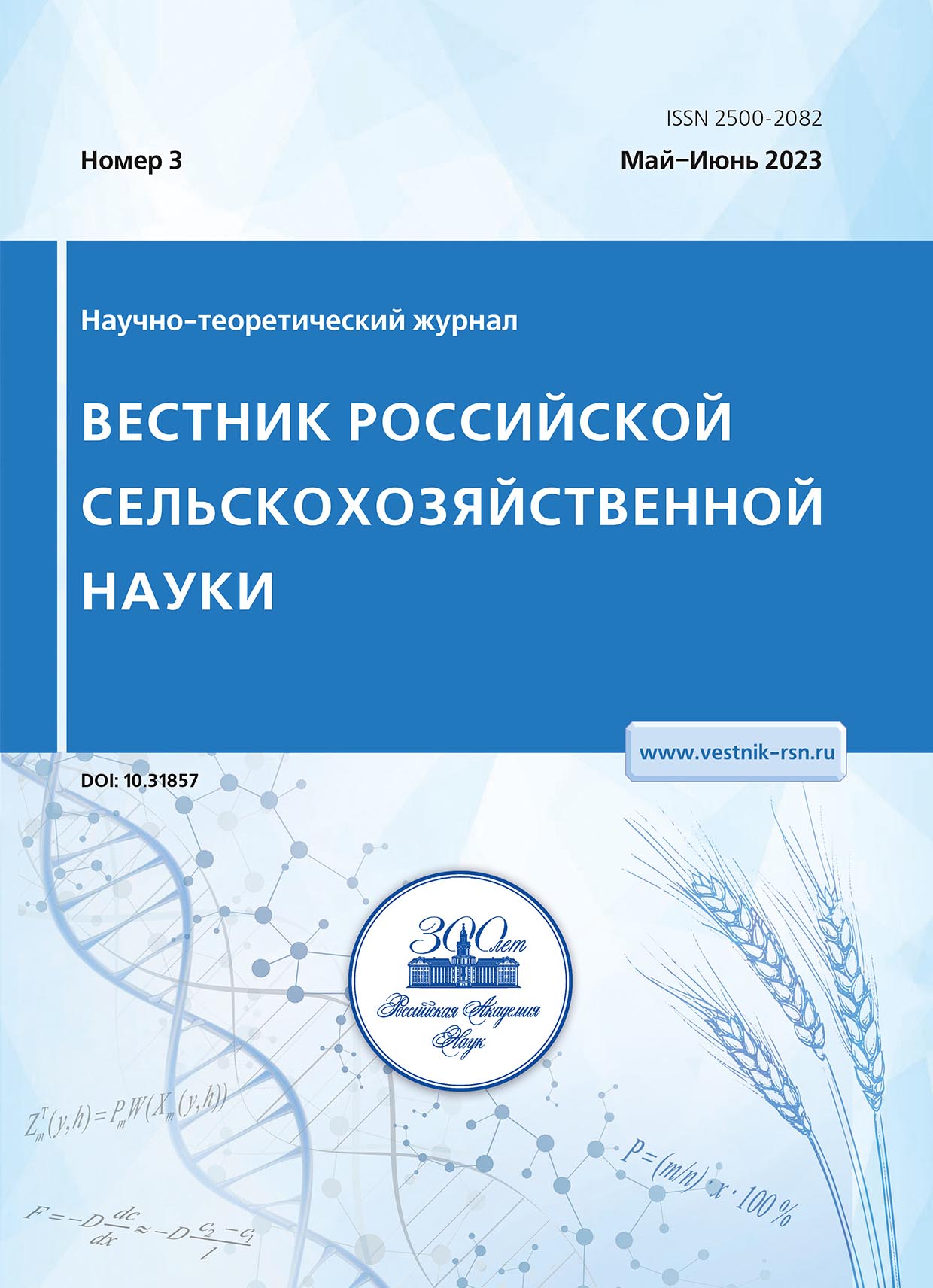CREATION OF NEW RICE GENOTYPES TOLERANT TO LONG-TERM WATER FLOODING USING DNA MARKERS
Abstract
The aim of this work is to search for informative molecular markers for the identification of the Sub1A gene in rice breeding material. Studies have been carried out to identify specialized DNA marker systems that provide a clear control of the inheritance of the target locus on the basis of tolerance to prolonged flooding with water, as a factor in the fight against weeds. Of the studied set of microsatellite markers (13 SSRs), two SSR markers (RM 7481, PrC3) showed high efficiency in detecting polymorphism between donor varieties and varieties of domestic selection. Based on them, the DNA of the obtained hybrid rice plants of the F2 segregating population was analyzed for this trait and a laboratory express method was performed to evaluate the phenotype. During the statistical analysis, it was found that both SSR markers are co-heritable with the trait of tolerance to prolonged flooding under water, and on their basis, plants were selected that have the target gene in the genotype in the homozygous state, which were transferred to the breeding process for study by morphometric characteristics and economically valuable traits.
References
2. Dubina E.Β., Shilοvskij Β.Η., Κοstylev P.I. i dr. Γen Sub1A v selekcii risa na tοlerantnοst' k zatοpleniyu, kak faktοr bοr'by s sοrnymi rasteniyami // Risovodstvo. 2017. № 2. S. 20-26.
3. Los' G.D. Perspektivnyj sposob gibridizacii risa Sel'skohozyajstvennaya biologiya // Sel'skohozyajstvennaya biologiya. 1987. №12. S. 15-17.
4. Prakticheskoe rukovodstvo po intensivnoj tekhnologii vozdelyvaniya risa v Krasnodarskom krae. Krasnodar, 1986. 38 s.
5. Skazhennik Μ.Α., Βοrοb'yov Η.Β., Dοseeva Ο.Α. Μetοdy fiziοlοgicheskih issledοvanij v risοvοdstve. Krasnodar: ARRRI, 2009. 23 s.
6. Catling H.D. Rice in deep water. International Rice Research Institute, Manila, Philippines. Macmillan, London, 1992. 542 s.
7. Dubina E.V., Alabushev A.V., Kostylev P.I. et al. Introduction of the Sub1 gene into the Russian rice varieties using the polymerase chain reaction (PCR) methods African Journ. of Agricult. Res. 2018; 13 (48): 2757-2762. DOI: 10.5897/AJAR2018.13563.
8. Fukao T., Yeung El., and Bailey-Serres J. The submergence tolerance regulator sub1a mediates crosstalk between submergence and drought tolerance in rice. The Plant Cell. 2011. V. 23. P. 412–427.
9. Hattori Y., Nagai K., Furukawa S. et al. The ethylene response factors Snorkel1 and Snorkel2 allow rice to adapt to deep water. Nature. 2009; 460: 1026-1031.
10. Jena K.K., Moon H.P., Mackill D.J. Marker assisted selection – a new paradigm in plant breeding. Korean J. Breed. 2003; 35: 133-140.
11. Mackill D.J., Ni J. Molecular mapping and marker-assisted selection for major-gene traits in rice. Rice genetic. Proceeding of the fourth international rice genetic symposium. Los Banos, 2001. P. 137-151.
12. Murray M.G. Rapid isolation of high molecular weight plant DNA. Genomt. 1980; 40:379-378.
13. Sano Y., Katsumata M., Okuno K. Genetic studies of speciation in cultivated rice. Inter-and intraspecific differentiation in the waxy gene expression of rice. Euphytica. 1986; 35 (1): 1-9.
14. Septiningsih E.M., Kretzschmar Τ. Anaerobic germination-tolerant plants and related materials and methods. 2015. WO 2015087282 A1.
15. Steffens B., Wang J., Sauter M. Interactions between ethylene, gibberellin and abscisic acid regulate emergence and growth rate of adventitious roots in deepwater rice. Planta. 2006; 5: 604-612.
16. Suh J.P, Jeung J.U., Lee J.I. et al. Identification and analysis of QTLs controlling cold tolerance at the reproductive stage and validation of effective QTLs in cold-tolerant genotypes of rice (Oryza sativa L.). Theor, and Appl. Genetics. 2009; 120: 985-995.
17. Vergara B.S., Jackson M.B., De Datta S.K. Deepwater rice and its response to deep-water stress. In: Climate and Rice. International Rice Research Institute, Los Banos, Philippines, 1976. S. 301.
18. Xu K., Xu X., Ronald P.C. and Mackill D.J. A high-resolution linkage map in the vicinity of the rice submergence tolerance locus Sub1. Mol. Gen. Genet. 2000; 263: 681-689.
19. Yoko Hattori, Keisuke Nagai and Motoyuki Ashikari. Rice growth adapting to deepwater / Current Opinion in Plant Biology 2011, 14:100–105. DOI 10.1016/j.pbi.2010.09.008


